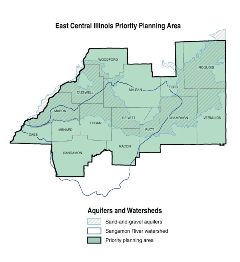East Central Illinois
 The East Central Illinois Region, encompassing within Cass, Champaign, Dewitt, Ford, Iroquois, Logan, Macon, Mason, McLean, Menard, Piatt, Sangamon, Tazewell, Vermilion, and Woodford counties, was identified as one of two primary regions for water supply planning in the Governor’s Executive Order 2006-01. The Water Survey's original technical report, published in 2011, focused on the Mahomet Aquifer System and the Sangamon River Watershed. In 2023, the model has been updated to simulate seasonal stresses resulting from irrigation.
The East Central Illinois Region, encompassing within Cass, Champaign, Dewitt, Ford, Iroquois, Logan, Macon, Mason, McLean, Menard, Piatt, Sangamon, Tazewell, Vermilion, and Woodford counties, was identified as one of two primary regions for water supply planning in the Governor’s Executive Order 2006-01. The Water Survey's original technical report, published in 2011, focused on the Mahomet Aquifer System and the Sangamon River Watershed. In 2023, the model has been updated to simulate seasonal stresses resulting from irrigation.
The Mahomet Aquifer provides approximately 800,000 people with drinking water. It is most intensively used in the Champaign-Urbana area, where there is a 100 foot cone of depression, and in the Havana Lowlands region, which is heavily irrigated. None of the current groundwater users in the Mahomet Aquifer is considered “at risk” for a future water shortage under modeled demand scenarios out to the year 2050. However, hydraulic conditions vary tremendously across the aquifer, and it is possible that demand from additional future high-capacity wells will have unacceptable impacts to private wells or baseflow in small streams. Seasonal drawdown is relatively uniform (2 to 8 feet) throughout the Mahomet Aquifer, which is notable because demands in the western portion of the aquifer are much higher than in the eastern portion in the summer. Simulated seasonal drawdown is overexaggerated in Mason City and east of Peoria, likely due to un-simulated geologic complexities.
A number of stakeholders have joined together to provide extensive real-time monitoring of groundwater levels throughout the Mahomet Aquifer, supplementing water supply planning efforts. Those monitoring efforts include the Imperial Valley, Mahomet Aquifer East, Northern Logan County, and the McTaz region. The ISWS anticipates completing a more intensive recharge investigation in the summer of 2025.
There are four major community surface water reservoir supply systems in the region: Bloomington, Danville, Decatur, and Springfield. Water budget analysis indicated that Springfield is an inadequate system (greater than a 50 percent probability that a shortage would occur during a drought of record condition), and Bloomington and Decatur are at-risk systems (greater than a 10 percent probability of shortage). These reservoirs also have water quality concerns, primarily elevated nitrate. Both Bloomington and Decatur recently installed wells to help with quality and supply concerns.
East Central Illinois Publications
- 2023 Model Update: Impacts of Irrigation on Mahomet Aquifer Water Levels
- Mahomet Aquifer Protection Task Force: Findings and Recommendations
- Meeting East-Central Illinois Water Needs to 2050: Potential Impacts on the Mahomet Aquifer and Surface Reservoirs
- A Plan to Improve the Planning and Management of Water Supplies in East-Central Illinois (2009) and 2015 update
- Water Demand Scenarios
for the East-Central Illinois Planning Region:
2005-2050